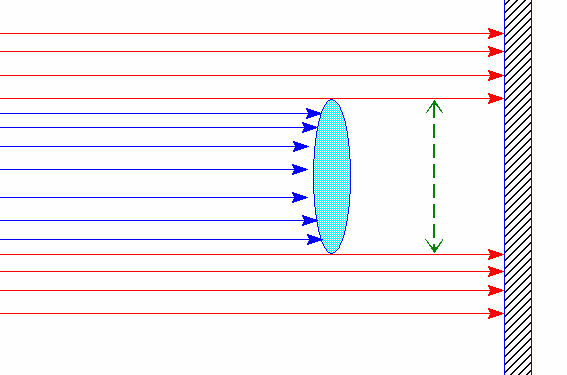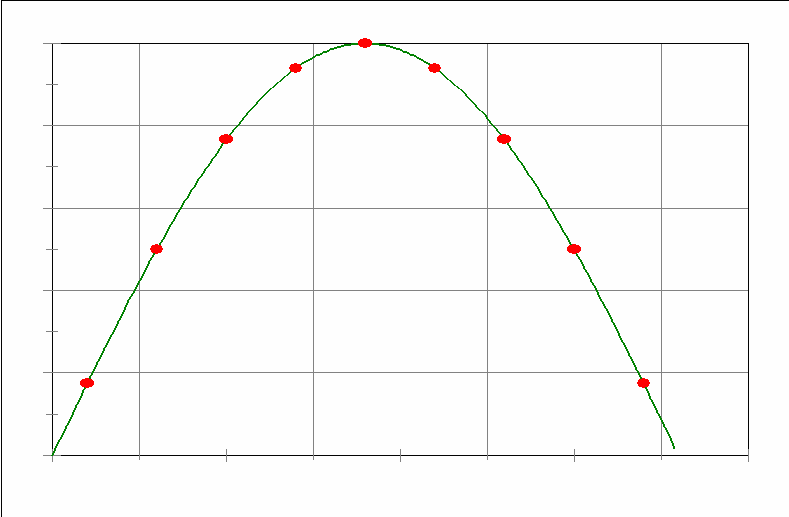Discussion of using an MRI to measure the size of a tumor
After having a second MRI performed on me and the Radiologist's report
that the schwannoma had shrunk, I started to think about whether this
statement could be made with 100% certainty given the method chosen to
view the schwannoma. For
those of you who work with me in Optical Proximity Correction, you will
see why it is not hard to question this statement as the sampling is
not so much different from OPC or ORC.
In a conventional xray film imaging, the photons are shot through the
body and collected on a film. The film is really just a macro-scopic
photon counter. The more photons received, the darker the film. Your
bone structure is an excellent blocker of xray photons, and as a
result, the bones "appear" white on these films. The important aspect
here is that by its very nature, given the quality of absorption or
blocking of xray photons, the maximum extent of the bone is shown.
This sketch can help describe what I mean:

In this sketch the xray photons are shown in red and blue arrows
traveling from left to right. The oval in the middle is blocking the
"blue" xray photons from reaching the film. The red xray photons reach
the film without interference. If this were real, where the red photons
hit the film, the film would be black, but where the blue photons were
blocked, the film would be white. The dotted green arrow could then
give you an accurate length of the oval. Note, though this is highly 2
dimensional in nature and would not be able to give you any information
on the width or depth of the oval. The xrays would have to come in from
multiple directions in order to extract that information. Presumably
this is what a CAT scan is doing.
However this technique is not very useful if you need to probe the
interior of the oval.
The MRI is working on a different principle. Instead of an electron -
photon scattering principle shown above, it is looking for a resonance
of the nucleus of an atom . To a physicist, MRI is just a
political spin term. The real term is Nuclear Magnetic Resonance. But
Nuclear is thought of negatively, hence the replacement name of
Magnetic Resonance Imaging, which is not as precise, as there is also
Electron Spin Resonance based on the same principles but looking at
electrons instead of the nucleus of an atom (not as useful for
medical imaging though). In any case, just google on nmr and you can
learn more than you ever wanted to know about this.
I will, however, start some gross simplifications on what is going on.
As the image is acquired, it is acquired in a 3 dimensional space (vs
the 2 dimensional space of a conventional xray). When you look at
a series of MRI images, each image represents a 2 dimensional
view at a specific third dimension coordinate. Or a series of planes
separated by some amount.
You could think if it this way

Here, the images are gathered along the red lines and the radiologist
is presented with 7 slices along the artifact. While there must be some
"depth" each slice, I think we can visualize them as infinitely thin.
While this is much much more powerful than the older conventional xray,
it is by no means perfect. It has its limitations as well
In particular, since it is only taking a finite number of infinitely
thin slices, information can be missed in the areas not sliced.
Imagine for a moment that you had a way to capture without loss the
full schwannoma. And then measured its diameter in the x and y plane as
a function of its position in the z plane. It might look
something like this:

(This is actually just y=sin(x) from 0 to 180 degrees)
Now imagine that the MRI sampled in its finite method only a fraction
of this curve (shown in the red points):

In this case we were lucky and hit the peak diameter.
But what if we shifted where the MRI sampled?

If we only sampled on the blue points and not the red points, we would
miss the maximum and the measurement of the size of the schwannoma
would not be accurate, and therefore saying that the schwannoma grew or
shrunk may also not be accurate. My schwannoma only shows up in three
images in a series, indicating a coarse sampling. Of course there are
other types of slices taken, some alone a different z-axis, and
perhaps in the hands of someone qualified a more accurate reading of
the size can be given.
This then brings up the following discussion. I can understand, how on
an initial MRI when one is not sure what one is looking for, doing a
coarse sampling in the z-axis. However, once something like my
schwannoma is found, why, on follow up MRIs, when the technician
injects the contrast enhancing dye, and sees the image come up on the
screen, the stepping in the z-axis is not taken down to the 3
dimensional pixel size of each data point or even lower?
Back to schwannoma home page
Back to snowedunder home page
This page last updated on Feb 26 at 10:31 am MST
Copyright 2006 - D. Samuels




